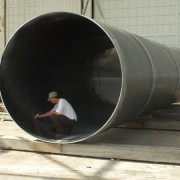A Tale of Two Materials – Chemical Resistance of FRP vs Alloys in Wet Processes
 There are many important predictors of service life in industrial chemical processes; for example, humidity, temperature, pressure, and stress. Similarly, chemical resistance is a key predictor of FRP service life in phosphate fertilizer processes where high chloride and fluoride levels exist. FRP have a considerable chemical resistance advantage in corrosive environments and they are cheaper to fabricate—all good news considering there is an increased demand for new corrosion solutions in these plants.
There are many important predictors of service life in industrial chemical processes; for example, humidity, temperature, pressure, and stress. Similarly, chemical resistance is a key predictor of FRP service life in phosphate fertilizer processes where high chloride and fluoride levels exist. FRP have a considerable chemical resistance advantage in corrosive environments and they are cheaper to fabricate—all good news considering there is an increased demand for new corrosion solutions in these plants.
According to a case study titled, “The Use of FRP in Phosphate Fertilizer and Sulphuric Acid Processes,” (2007) released by Ashland Performance Materials, Dublin, OH, FRP made from epoxy vinyl ester resin has the chemical resistance necessary for long-term service life- in many cases 50 years and counting. When compared to Alloy C-276 (clad carbon steel), 2205 stainless steel, and nickel alloy, FRP demonstrated superior chemical resistance and cost-effectiveness in “wet process” phosphoric acid and sulfuric acid environments found in phosphate fertilizer plants.
Epoxy Vinyl Ester Resin Chemical Resistance Compared to Metal
|
Materials |
Sulfuric Acid |
Hydrochloric Acid |
Acid Chloride Salts |
|
FRP made with epoxy vinyl ester resin |
100˚C to 30% |
80˚C to 15% |
100˚C all conc. |
|
2205 stainless steel |
30˚C to 30% |
60˚C to 1% |
65˚C to 2000ppm @lower pH |
|
Alloy C-276 |
100˚C to 30% |
80˚C to 15% |
65˚C to 50ppm @ lower pH |
* Taken from the 2007 Ashland Performance Materials Case Study-
“The Use of FRP in Phosphate Fertilizer and Sulphuric Acid Processes”
The demand for corrosion resistant products began to increase in 2007 when nickel hit an all time high of $24/lb. According to the International Monetary Fund, as the global economy strengthens and developing nations increase their infrastructure build, base metal pricing – most notably copper, nickel and stainless steel are expected to continue their upward march. While the price of nickel has come down considerably the market is generally considered volatile and the demand for corrosion resistant products continues to increase.
According to a different study released in 2011, by Ashland Performance materials, considerable savings can be realized when choosing FRP construction materials. In 2011, shop and field fabricated FRP approximately cost $50-$75/Sq Ft. compared to 2205 stainless steel at $225/Sq Ft. and C-276 clad carbon steel at $330/Sq Ft. respectively.
So where does this leave FRP and is there any anticipated growth? According to a 2009 study by the Food and Agriculture Organization of the United Nations (FAO), titled “World Fertilizer Trends and Outlook to 2013,” based on longer-term population and income projections, global food production needs to increase more than 40% by 2030 and 70% by 2050 –all things considered the phosphate and FRP industry could stand to benefit from the projected increased demand for calories, combined with upward trending metal prices.
As global food production increases along side population growth, so will the need for phosphate bases fertilizers —FRP will be ready. FRP are a superior chemical and corrosion resistant materials option, at a price much lower and much more stable than that of traditionally used alloys such as nickel- in “wet process” phosphate fertilizer plants. Furthermore, FRP provide engineers, architects, and designers with a reliable, cost-effective construction material that can be employed in a myriad of corrosive applications.













